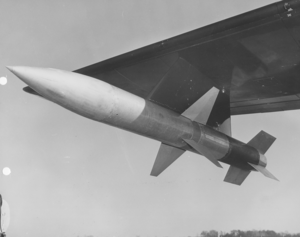Air-to-air missile
| AAM-N-4 Oriole |
|---|
 |
| Type | Air-to-air missile |
|---|
| Place of origin | United States |
|---|
|
| In service | 1950–1955 |
|---|
| Used by | United States Navy |
|---|
|
| Designed | 1947 |
|---|
| Manufacturer | Martin |
|---|
|
| Mass | 1,500 pounds (680 kg) |
|---|
| Length | 11 feet 7 inches (3.53 m) |
|---|
| Diameter | 11 inches (280 mm) |
|---|
| Wingspan | 3 ft 2.8 in (0.986 m) |
|---|
|
| Warhead | High explosive |
|---|
| Warhead weight | 25 pounds (11 kg) |
|---|
|
Operational
range | 10 miles (16 km) |
|---|
| Flight altitude | Max at launch, 10 miles (16 km) |
|---|
| Mach 2.5 |
|---|
Guidance
system | Active radar homing |
|---|
The AAM-N-4 Oriole was an early American air-to-air missile, developed by the Glenn L. Martin Company for the United States Navy. Designed for launch from carrier-based aircraft, the missile programme was cancelled before flight testing began, and the missiles produced were utilized as test vehicles.
Design and development
Development of the AAM-N-4 Oriole began in 1947, when a development contract was awarded by the United States Navy's Bureau of Ordnance to the Glenn L. Martin Company to develop a heavy air-to-air missile,[1] utilizing active radar homing for fire and forget operation,[2] for launch from aircraft operating from aircraft carriers.[3] Oriole was intended to utilize a rocket[4] or rocket-ramjet propulsion system; the intended range of the weapon was 20 miles (32 km),[5] however as tested it was limited to a range of approximately 10 miles (16 km).[3] Ready for launch, the missile weighed 1,500 pounds (680 kg),[6] and used cruciform fins at the missile's midbody and at the tail for flight control.[7] Flight speed was originally intended to be above Mach 3.[8]
In 1948, the Oriole contract was redefined to be a guidance development program instead of a project to develop an operational missile; the program to construct test vehicles resumed in 1950 for research and development purposes,[9] the missiles being redesignated RTV-N-16.[3] Flight testing began shortly thereafter at the Naval Air Missile Test Center at Point Mugu, California; testing continued through 1953, with 56 flight tests being conducted throughout the program;[9] as built the missile proved to be capable of Mach 2.5.[7] The Oriole program was terminated at the end of 1953.[10]
